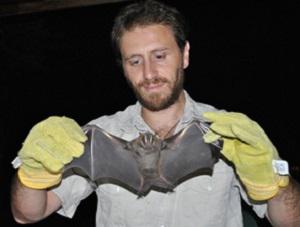Andrés Gabriel Palmerio
This project is aimed to the study and conservation of bat species present in a Important Area for Conservation of Bats called Osununú/Teyú Cuaré

AGP and Artibeus lituratus.
This project is aimed to the study and conservation of bat species present in Osununú and Teyú Cuaré, San Ignacio, Misiones province, Argentina. The fauna of bats inhabiting Argentina is composed of 62 species of 4 families. The lack of existing knowledge about many of the species that inhabit our country is a factor that negatively influences the conservation of bats and the destruction of their natural habitats. This adds to the fact that society does not consider bats as a charismatic species, but rather as a nuisance or a health hazard, unworthy of protection.
Osununú Natural Reserve and Teyú Cuaré Provincial Park have been certified as an Important Area for Conservation of Bats by the Latin American Network of Conservation of Bats in terms of their richness and characteristics of the species found there. This project will provide valuable information about the behavior and habitat requirements of species with conservation concerns as Vampyressa pusilla , characterized as Data Deficient, Glossophaga soricina, Carollia perspicillata and Pygoderma bilabiatum as Vulnerable and Artibeus lituratus, Artibeus fimbruatus, Platyrrhinus lineatus and Nictinomops laticaudatus as Near Threatened by the Argentinean Society for the Study of Mammals, at its southernmost distribution and thus assess possible conservation action. The area has distinctive characteristics of soil, topography and climate, with components of Brazilian Cerrado flora that gives it great importance of conservation as well. Therefore, generating information on these species and their relation with native vegetation, is vital. The richness of bat species found on the area is probably due to the large number of sheltering possibilities that the cliffs and caves bordering the Paraná River provide.
Information on the social behavior of this group will be recorded by installing two wireless infrared cameras at the mixed reproductive refuge of G. soricina and C. perspicillata to study their activity cycles, time spent feeding pups and assess the interactions between both species, that will be compared with data obtained in the Northern Hemisphere. Feces traps will also be placed to study both species’ seasonal feeding variations. The obtained information will be used to design the management plans of the protected area.
Reserve guards and rangers will be trained in data and sample collection and the information collected will be used to carry out final work on rangers’ school and degree thesis for the province’s university.
Our goal is to increase awareness of bat species of the area conducting outreach and education actions with the area`s visitors, while permitting measurements and conservation management.